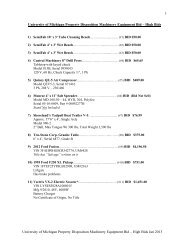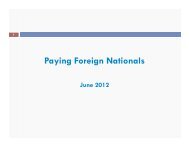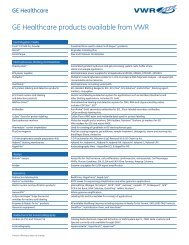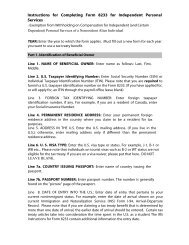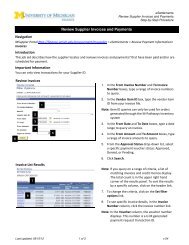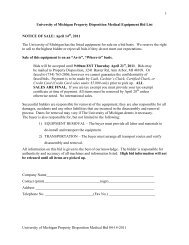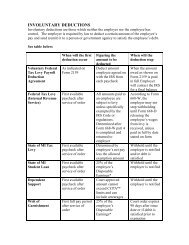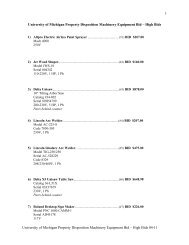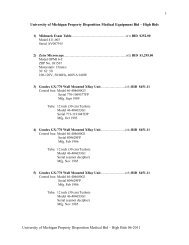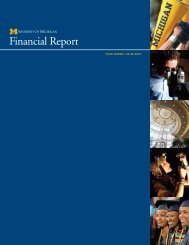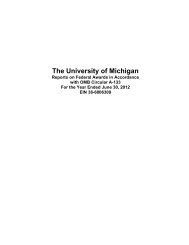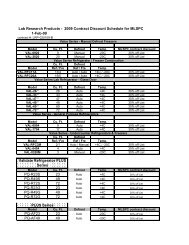2010 A-133 Report - Finance - University of Michigan
2010 A-133 Report - Finance - University of Michigan
2010 A-133 Report - Finance - University of Michigan
You also want an ePaper? Increase the reach of your titles
YUMPU automatically turns print PDFs into web optimized ePapers that Google loves.
THE UNIVERSITY OF MICHIGAN<br />
Notes to Consolidated Financial Statements--Continued<br />
Note 2--Cash and Investments--Continued<br />
Authorizations: The <strong>University</strong>’s investment policies are governed and authorized by<br />
<strong>University</strong> Bylaws and the Board <strong>of</strong> Regents. The approved asset allocation policy for the<br />
Long Term Portfolio sets a general target <strong>of</strong> 80 percent equities and 20 percent fixed income<br />
securities, within a permitted range <strong>of</strong> 65 to 90 percent for equities and 10 to 35 percent for<br />
fixed income securities. Since diversification is a fundamental risk management strategy, the<br />
Long Term Portfolio is broadly diversified within these general categories.<br />
Distributions are made from the <strong>University</strong> Endowment Fund to the <strong>University</strong> entities that<br />
benefit from the endowment fund. The endowment spending rule provides for an annual<br />
distribution <strong>of</strong> 5 percent <strong>of</strong> the one-quarter lagged seven year moving average fair value <strong>of</strong> fund<br />
units, limited to 5.3 percent <strong>of</strong> the current fair value to protect endowment principal in the event<br />
<strong>of</strong> a prolonged market downturn. Distributions are also made from the <strong>University</strong> Investment<br />
Pool to <strong>University</strong> entities based on the 90-day U.S. Treasury Bill rate. The <strong>University</strong>’s costs<br />
to administer and grow the <strong>University</strong> Endowment Fund and <strong>University</strong> Investment Pool are<br />
funded by investment returns.<br />
Cash and Cash Equivalents: Cash and cash equivalents, which totalled $194,645,000 and<br />
$358,373,000 at June 30, <strong>2010</strong> and 2009, respectively, represent short-term money market<br />
investments in mutual funds, overnight collective funds managed by the <strong>University</strong>’s custodian<br />
or short-term highly liquid investments registered as securities and held by the <strong>University</strong> or its<br />
agents in the <strong>University</strong>'s name. Of its cash and cash equivalents, the <strong>University</strong> had actual<br />
cash balances in its bank accounts in excess <strong>of</strong> Federal Deposit Insurance Corporation limits in<br />
the amount <strong>of</strong> $6,838,000 and $10,788,000 at June 30, <strong>2010</strong> and 2009, respectively. The<br />
<strong>University</strong> does not require deposits to be collateralized or insured.<br />
Investments: At June 30, <strong>2010</strong> and 2009, the <strong>University</strong>'s investments, which are held by the<br />
<strong>University</strong> or its agents in the <strong>University</strong>'s name, are summarized as follows:<br />
40<br />
<strong>2010</strong> 2009<br />
(in thousands)<br />
Cash equivalents, noncurrent $ 122,474 $ 181,564<br />
Fixed income securities 1,372,232 1,261,477<br />
Commingled funds 1,379,961 1,399,681<br />
Equity securities 819,510 781,719<br />
Nonmarketable alternative investments 4,024,853 3,502,987<br />
Other investments 6,775 6,125<br />
$ 7,725,805 $ 7,<strong>133</strong>,553



